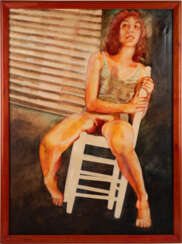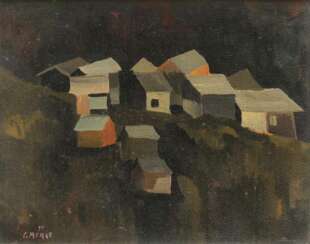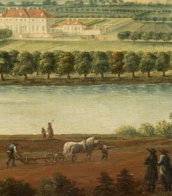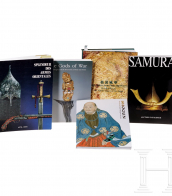menge

Anna Maria Mengs was a German painter of the second half of the 18th century. She is known as a painter and graphic artist, famous for her portraits.
Anna Maria Mengs was the daughter of Anton Raphael Mengs, a famous German painter and representative of classicism, from whom she studied painting. In 1777 she married the Spanish engraver Manuel Salvador Carmona and had seven children. Despite family obligations, she continued to paint miniatures and pastels, as contemporaries noted, with talent and exquisite taste. In 1793, a year after her death, her work was exhibited at the Accademia de San Fernando in Madrid.


Anton Raphael Mengs was a German painter, active in Dresden, Rome, and Madrid, who while painting in the Rococo period of the mid-18th century became one of the precursors to Neoclassical painting, which replaced Rococo as the dominant painting style in Europe.


Anton Raphael Mengs was a German painter, active in Dresden, Rome, and Madrid, who while painting in the Rococo period of the mid-18th century became one of the precursors to Neoclassical painting, which replaced Rococo as the dominant painting style in Europe.


Yangyang Meng is a Chinese visual artist who lives and works in Beijing. In her art she realizes her emotionality and ability to think outside the box and take risks as an adventurer. The artist easily plays with color, lines and shadows on her canvases.


Anton Raphael Mengs was a German painter, active in Dresden, Rome, and Madrid, who while painting in the Rococo period of the mid-18th century became one of the precursors to Neoclassical painting, which replaced Rococo as the dominant painting style in Europe.


Anton Raphael Mengs was a German painter, active in Dresden, Rome, and Madrid, who while painting in the Rococo period of the mid-18th century became one of the precursors to Neoclassical painting, which replaced Rococo as the dominant painting style in Europe.


Anton Raphael Mengs was a German painter, active in Dresden, Rome, and Madrid, who while painting in the Rococo period of the mid-18th century became one of the precursors to Neoclassical painting, which replaced Rococo as the dominant painting style in Europe.


Yangyang Meng is a Chinese visual artist who lives and works in Beijing. In her art she realizes her emotionality and ability to think outside the box and take risks as an adventurer. The artist easily plays with color, lines and shadows on her canvases.


Yangyang Meng is a Chinese visual artist who lives and works in Beijing. In her art she realizes her emotionality and ability to think outside the box and take risks as an adventurer. The artist easily plays with color, lines and shadows on her canvases.


Anton Raphael Mengs was a German painter, active in Dresden, Rome, and Madrid, who while painting in the Rococo period of the mid-18th century became one of the precursors to Neoclassical painting, which replaced Rococo as the dominant painting style in Europe.


Max Bill, a Swiss artist, architect, painter, typeface designer, industrial designer, and graphic designer, emerged as a key figure in 20th-century art and design. Born in Winterthur, Switzerland, in 1908, Bill's education at the Bauhaus under luminaries like Wassily Kandinsky, Paul Klee, and Oskar Schlemmer profoundly influenced his multidisciplinary approach. His work spans from graphic design, where he was instrumental in shaping Swiss design from the 1950s, to product design with iconic creations like the Ulmer Hocker, a versatile stool designed in 1954.
Bill's contributions to concrete art and his role in founding the Ulm School of Design alongside Inge Aicher-Scholl and Otl Aicher in 1953, mark him as a pioneer who blurred the lines between art, design, and architecture. His theoretical writings and teaching at the Ulm School further underscored his commitment to integrating art with science, shaping a generation of designers and artists.
Noteworthy among his architectural works are his own house and studio built in Zurich-Höngg in the early 1930s and a series of public sculptures that challenge perceptions and engage public spaces in innovative ways. His legacy also includes influential roles in politics, contributions to the field of education, and the establishment of foundations to preserve his work and ideals.
Bill's extensive oeuvre, which also includes timepieces designed for Junghans and a multitude of sculptures, demonstrates his belief in the unity of form and function and the possibility of art to embody the principles of the new physics of the 20th century. His works are not only held in high regard for their aesthetic and functional qualities but also for their ability to convey complex theoretical ideas in tangible forms.
For collectors and experts in art and antiques, Max Bill remains a figure of immense importance, whose works continue to inspire and influence contemporary design and art practices. Sign up for updates related to Max Bill to stay informed about new product sales and auction events showcasing his remarkable contributions to modern art and design.









































































